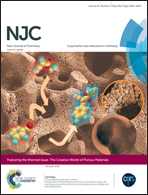Simultaneous determination of cationic dyes in water samples with dispersive liquid–liquid microextraction followed by spectrophotometry: experimental design methodology
Abstract
In this work, dispersive liquid–liquid microextraction (DLLME) was applied for simultaneous preconcentration and subsequent spectrophotometric determination of auramine-O (AO) and methylene blue (MB) in water and wastewater samples. The parameters corresponding to DLLME such as extraction solvent (CHCl3), disperser solvent (ethanol), pH of sample solution, centrifuge time and ionic strength were studied by central composite design (CCD) combined with response surface methodology (RSM) and desirability function (DF) using STATISTICA. The optimal conditions were set as 150 μL of chloroform (extraction solvent), 800 μL of ethanol (disperser), pH = 6.0 and 4 min centrifuge time in the absence of any salt. At the optimum specified conditions, a linear response was seen over 10–2000 ng mL−1 with a correlation coefficient (R2) of 0.9984 for AO and at 5–3000 ng mL−1 with a correlation coefficient (R2) of 0.9995 for MB, respectively. The limits of detection (LODs) based on similar replicates of (N = 15) blank solution (S/N = 3 criterion) signal measurements and limits of quantification (LOQs) were 2.628 and 0.788 ng mL−1, and 8.759 and 2.625 ng mL−1 for AO and MB, respectively. The efficiency in terms of recoveries was 93.9–99.2% for MB and 92.4–99.7% for AO (n = 10) and the enrichment factor (EF) was 106.10 for MB and 96.73 for AO. Finally, the method was successfully applied for AO and MB estimation in water samples with relative recoveries in the range of 92–99%. The influence of interfering substances such as foreign ions and dyes which might be present in their samples was examined and experimental results confirm reasonable and moderate selectivity of the protocol being studied.


 Please wait while we load your content...
Please wait while we load your content...